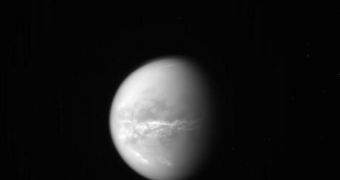The NASA Cassini space orbiter has beamed back a series of photos of the Saturnine moon Titan, which show that spring is finally beginning to take a hold there. Clouds have already begun forming.
Investigators with the mission say that the midsection of the moon is covered with clouds, which give the body an eerie appearance.
The last summer season in the southern hemisphere (winter in the northern hemisphere) began in July 2004, and ended in April 2010, just a few months ago.
Given the length of each season on Titan, it stands to reason that the transformations don't take only a few months as they do here on Earth. Given the distance Saturn is from the Sun, each season on its largest moon lasts for about 7 years.
Between seasons, great atmospheric and surface variations can be recorded on the space rock, experts say, and Cassini is having a front-row seat to the show. Thanks to a new mission extension, the orbiter will be able to conduct even more observations of its preferred target.
“Over the past six years, we’ve found that clouds appear clustered in three distinct latitude regions of Titan: large clouds at the north pole, patchy cloud at the south pole and a narrow belt around 40 degrees south,” said expert Sebastien Rodriguez, from the Universite Paris Diderot's AIM laboratory.
“However, we are now seeing evidence of a seasonal circulation turnover on Titan – the clouds at the south pole completely disappeared just before the equinox and the clouds in the north are thinning out,” the scientist said.
The new raw images were taken on October 18 from an altitude of about 2.5 million kilometers (1.5 million miles) above the surface of Titan. The icy Saturnine moon Tethys can also be seen in some images.
Because of the hazy atmosphere surrounding Titan, snapping photos in visible light wavelengths is impossible. Cassini therefore needs to use its radars for the job, as radio wavelengths can easily pierce the thick layer of clouds covering the areas of interest.
The Cassini mission, a joint project of NASA, the European Space Agency and the Italian Space Agency, arrived at Saturn and achieved orbital insertion around the gas giant on July 1, 2004.
The project is being managed for NASA by the Jet Propulsion Laboratory (JPL), at the California Institute of Technology, in Pasadena.

 14 DAY TRIAL //
14 DAY TRIAL //